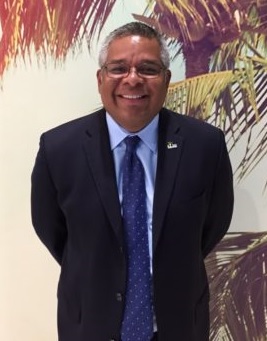
Paula Ilonze
.
LOS ANGELES — You can only find the entrance to the RightWay Foundation if you’re really looking for it. Hidden deep within the parking structure for a South Central Los Angeles shopping plaza, the foundation aims to help foster youth learn basic life skills (how to open a bank account, for example), get counseling for the trauma they’ve likely endured and navigate the transition to young adulthood.
“The foster care program is broken right now,” said Franco Vega, the foundation’s executive director. The solution, he said, is for Los Angeles County’s Department of Children and Family Services (DCFS) — the largest locally run child welfare system in the nation — to make sure its employees are “trained properly” in dealing with foster kids.
“It just comes down to no one knows how to work with our babies, especially in South Central,” he said. “They do not know how to handle tough kids, or kids who appear to have attitude problems. Some of our social workers take it personal. You get cursed out by a kid, they’re not cursing you out. They’re cursing out what they went through. If you can’t display that you have compassion and you’re there for the kid, forget about it. Our kids will smell fakeness, they can smell fake cologne a mile away.”

RightWay Foundation
Franco Vega
In Los Angeles, those interactions between social workers and kids are frequent: LA had the third-highest “rate of removal” of children from their families last year among the 10 largest U.S. cities. But removing lots of children from their homes doesn’t necessarily translate to those children being safer, some advocates caution.
In the short term, vast numbers of children under county care can overwhelm the system, allowing kids who really are in acute danger to slip through the cracks. And in the long term, there is considerable evidence suggesting that for the most part, kids who stay with parents (or extended family) can expect better outcomes in life.
“We’re definitely understanding the need for trauma-informed practice,” said Diane Iglesias, senior deputy director at DCFS, “and we have also recognized the trauma in our workers, which at times can interfere with their ability to be effective.”
The system’s sheer enormity — 30,000 children and their families — is staggering. But apart from its massive size, the issues that plague LA’s system are not unique. The overrepresentation of black families in the system, for example, or the obstacles facing kids who age out of the system without a permanent home are national issues. LA’s child welfare system is the national system in a microcosm.
What follows is a look at three major factors — disastrous situations that make the headlines, poverty and the challenges of getting out of the system once you’re in — that contribute to the size of LA’s child welfare system.
Fallout from tragedy
“LA has had some very high-profile tragedies” involving children killed by family members or family members’ significant others, said Sara Bartosz, deputy director of litigation strategy at the New York-based nonprofit Children’s Rights. “Rightly, these tragedies make it into the papers, and people care, and that can lead to higher levels of intakes and then the system’s capacity gets challenged. The safety net gets stretched and, too frequently, shredded.”
 The 2013 death of 8-year-old Gabriel Fernandez is still working its way through the justice system, with four former DCFS employees involved with Fernandez awaiting trial on charges of felony child abuse and falsifying public records. This is the first time in Los Angeles County that social workers have faced criminal charges in relation to the death of a child.
The 2013 death of 8-year-old Gabriel Fernandez is still working its way through the justice system, with four former DCFS employees involved with Fernandez awaiting trial on charges of felony child abuse and falsifying public records. This is the first time in Los Angeles County that social workers have faced criminal charges in relation to the death of a child.
One 10-year veteran of the DCFS, a social worker who spoke to Youth Today on condition of anonymity, said the suit “terrified people” in the department and that some supervisors are working from a place of fear. “If they have had a child fatality on their caseload … then they may be more likely to supervise in response to that experience and be very conservative moving forward,” the social worker said.
Kenneth Krekorian, executive director of Los Angeles Dependency Lawyers, confirmed that this is the case. Over the past five years or so, he and his colleagues’ caseloads have skyrocketed. Best practice would be for each attorney representing a parent in dependency court to handle around 100 cases each, Krekorian said, but his organization’s attorneys are working around 285 each.
“Social workers are too busy to do the necessary research, so they file a petition to be better safe than sorry,” Krekorian said. “It’s human nature, and it’s better to err on the side of the child — and I say that as a parents’ attorney.”
The downside to that natural instinct is when a jurisdiction finds itself in a “foster care panic,” the term that National Coalition for Child Protection Reform Executive Director Richard Wexler uses for the dramatic increase in child removals that often follows a tragedy like the Fernandez case. It may lead to an overall decrease in child safety when the child welfare system is too overwhelmed with cases to notice kids in acute danger.
Iglesias pointed out that in the wake of tragedy, there’s an uptick in calls to DCFS, which leads to an uptick in detentions: “The police respond, [DCFS] responds and mandated reporters respond.” The way to interrupt that cycle, she said, is to be aware of it and its pitfalls. “Being trauma-informed is understanding that removing the child from a home is a trauma,” she said. That way, “I think we can stop the knee-jerk response.”
The poverty factor
In 2016, 21.5 percent of LA city residents lived in poverty, well above the federal rate of 12.7 percent. The ways in which poverty sometimes can be conducive to actual neglect — homelessness, contact with the criminal justice system, caregivers’ untreated depression or food insecurity, to name a few — may at times be mistaken for neglect or abuse by social workers.
“Poverty is one important factor [in the number of families involved with DCFS] that a lot of people are ignoring,” Vega said, emphasizing that children and families living in poverty are the ones who tend to appear on DCFS’ radar.

CASA of Los Angeles
Wende Nichols-Julien
“If you’re born in poverty and you come to school looking dirty, like you haven’t been cleaned, then that opens up the door for an investigation” if a concerned teacher or social worker calls a hotline, he said. “Before they get into the foster care system, a lot of families are homeless — it’s not illegal or a violation to be homeless with your kids, it just brings up a red flag” when families try to take advantage of services for homeless people.
For its part, DCFS firmly refutes the idea that poverty has a role in child removals. “Our workers have enough cases that they don’t need to try to do social engineering and pull kids out of poverty situations,” Iglesias said.
But poverty’s role in the system might be subtler than conscious attempts at social engineering.
Conventional wisdom about DCFS is that it struggles with a shortage of available foster care families. Some advocates think that formulation is backwards, however: “That isn’t the problem,” said Wende Nichols-Julien, CEO of CASA of Los Angeles. The problem, she said, is that too many kids in Los Angeles County are removed from their homes.
Offering a theory as to why there are so many removals, she pointed to the “overuse of a system that is really addressing symptoms around poverty, substance abuse, mass incarceration, homelessness and other issues that lead families into the system.” We aren’t offering enough services to struggling families before the situation becomes dire and a child is removed from the home, she said. “And then people get into the system, and they get stuck.”
Stuck in the system
Denise Johnston is the director of Families and Criminal Justice, an LA-based nonprofit that works with incarcerated mothers to preserve relationships with their children. “The removal issue,” she said, “is the result of a combination of scrutiny and discrimination.”
For example, “pregnant women who give birth while incarcerated have a newborn removal rate of 30 to 50 percent, but if they get released and give birth in the community, the rate is less than 10 percent. And those removals are typically based upon a currently open child welfare case or a positive drug test,” she said. The difference, she pointed out, is that women giving birth in custody are subject to more surveillance than a woman giving birth in the community.
This surveillance that can accompany poverty — such as when a parent applies for various county services for low-income or homeless families — can put a family on DCFS’ radar, for better or for worse.
The upside, of course, is that a child might be removed from danger. The downside, Kerkorian pointed out, is that once a family has an open DCFS case, getting out is not easy. His clients struggle to meet the court-mandated requirements they must satisfy to reunite with their children, and that can spark a vicious cycle: “When kids are taken away, that takes away a source of funding for parents. So they might become homeless and can’t get their kids back for that reason, and they can’t get a job if they’re traveling to court-mandated drug counseling all day. But they need counseling to regain custody.”
Moving forward
As of Dec. 1, 2017, DCFS had a new leader: Bobby Cagle, formerly the commissioner of Georgia’s Division of Family and Children Services. Here are some key areas experts say Cagle needs to address:
Address housing issues:
“The housing crisis and homelessness are very serious problems that impacts people’s ability to care for their children because they’re working two or three jobs, or they don’t have sufficient living situations, so they end up in situations that are called neglect or that are neglect because of the poverty that they’re living in due to the housing crisis,” Nichols-Julien said.
Make sure parents are provided the baseline of “reasonable services” they are entitled to:
“LA doesn’t provide adequate services to parents [before DCFS taps them], so problems that might have been resolved through services get larger and there’s a filing as a result of that,” Kerkorian said. “We have a lot of mental illness with our clients and there’s not enough funding to give them counseling. Most of our clients have anger management, substance abuse or mental health issues, or all three, and to get adequate counseling is expensive. The county is supposed to provide reduced fees for counseling but it doesn’t always happen, or it may take a parent three hours each way to get to counseling, or a program is full” and a parent can’t get a spot, and therefore can’t meet the requirements for reunification with his or her child.
Bring an awareness of trauma into the relationships between foster youth and DCFS:
“You can’t learn this from a book,” Vega said. “It’s compassion, teaching them how to be warm and empathetic.”
This story has been updated.































